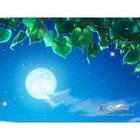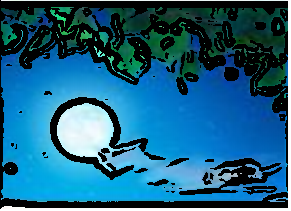 //
-----------------------------------------------------------------------------
//
----------------------------------------------------------------------------- //
Name: Sobel.fx
//
Name: Sobel.fx //
//
 //
Description:
//
Description:  //
//
 //
-----------------------------------------------------------------------------
//
-----------------------------------------------------------------------------
 //
-----------------------------------------------------------------------------
//
----------------------------------------------------------------------------- //
Effect File Variables
//
Effect File Variables //
-----------------------------------------------------------------------------
//
-----------------------------------------------------------------------------

 float4x4 worldViewProj : WorldViewProjection;
//
This matrix will be loaded by the application
float4x4 worldViewProj : WorldViewProjection;
//
This matrix will be loaded by the application

 texture testTexture;
//
This texture will be loaded by the application
texture testTexture;
//
This texture will be loaded by the application
 const
float
Brightness
=
1.0f
;
const
float
Brightness
=
1.0f
;
 sampler Sampler
=
sampler_state
sampler Sampler
=
sampler_state
 ...
{
...
{ Texture = (testTexture);
Texture = (testTexture); MipFilter = LINEAR;
MipFilter = LINEAR; MinFilter = LINEAR;
MinFilter = LINEAR; MagFilter = LINEAR;
MagFilter = LINEAR; }
;
}
;
 //
-----------------------------------------------------------------------------
//
----------------------------------------------------------------------------- //
Vertex Definitions
//
Vertex Definitions //
-----------------------------------------------------------------------------
//
-----------------------------------------------------------------------------
 //
Our sample application will send vertices
//
Our sample application will send vertices  //
down the pipeline laid-out like this...
//
down the pipeline laid-out like this...

 struct
VS_INPUT
struct
VS_INPUT
 ...
{
...
{ float3 position : POSITION;
float3 position : POSITION; float2 texture0 : TEXCOORD0;
float2 texture0 : TEXCOORD0; }
;
}
;
 //
Once the vertex shader is finished, it will
//
Once the vertex shader is finished, it will  //
pass the vertices on to the pixel shader like this...
//
pass the vertices on to the pixel shader like this...

 struct
VS_OUTPUT
struct
VS_OUTPUT
 ...
{
...
{ float4 hposition : POSITION;
float4 hposition : POSITION; float2 texture0 : TEXCOORD0;
float2 texture0 : TEXCOORD0; float4 color : COLOR0;
float4 color : COLOR0; }
;
}
;
 //
And finally, the pixel shader will send a single
//
And finally, the pixel shader will send a single  //
color value to the frame buffer like this...
//
color value to the frame buffer like this...

 struct
PS_OUTPUT
struct
PS_OUTPUT
 ...
{
...
{ float4 color : COLOR;
float4 color : COLOR; }
;
}
;
 //
-----------------------------------------------------------------------------
//
----------------------------------------------------------------------------- //
Simple Vertex Shader
//
Simple Vertex Shader //
-----------------------------------------------------------------------------
//
-----------------------------------------------------------------------------

 VS_OUTPUT myvs( VS_INPUT IN )
VS_OUTPUT myvs( VS_INPUT IN )
 ...
{
...
{ VS_OUTPUT OUT;
VS_OUTPUT OUT;
 OUT.hposition = mul( worldViewProj, float4(IN.position, 1) );
OUT.hposition = mul( worldViewProj, float4(IN.position, 1) );
 OUT.color = float4( 1.0, 1.0, 1.0, 1.0 ); // Pass white as a default color
OUT.color = float4( 1.0, 1.0, 1.0, 1.0 ); // Pass white as a default color //OUT.color = float4( 0.0, 1.0, 0.0, 1.0 ); // Pass green to test vertex shader
//OUT.color = float4( 0.0, 1.0, 0.0, 1.0 ); // Pass green to test vertex shader
 OUT.texture0 = IN.texture0;
OUT.texture0 = IN.texture0;
 return OUT;
return OUT; }
}

 //
-----------------------------------------------------------------------------
//
----------------------------------------------------------------------------- //
Simple Pixel Shader
//
Simple Pixel Shader //
-----------------------------------------------------------------------------
//
-----------------------------------------------------------------------------

 PS_OUTPUT myps( VS_OUTPUT IN )
PS_OUTPUT myps( VS_OUTPUT IN )
 ...
{
...
{ PS_OUTPUT OUT;
PS_OUTPUT OUT;
 // OUT.color = tex2D( Sampler, IN.texture0 ) * IN.color;
// OUT.color = tex2D( Sampler, IN.texture0 ) * IN.color;
 // If you uncomment the next line, the color passed to us by our
// If you uncomment the next line, the color passed to us by our // vertex shader and the selected texture sampler will be ignored
// vertex shader and the selected texture sampler will be ignored  // completely and all output to the frame buffer will be blue regardless.
// completely and all output to the frame buffer will be blue regardless.
 //OUT.color = float4( 0.0, 0.0, 1.0, 1.0);
//OUT.color = float4( 0.0, 0.0, 1.0, 1.0);

 const int NUM = 9;
const int NUM = 9; const float threshold = 0.09;
const float threshold = 0.09; const float texW = 140.f;
const float texW = 140.f; const float texH = 140.f;
const float texH = 140.f;
 //round texels
//round texels
 const float2 c[NUM] =...{
const float2 c[NUM] =...{ float2( -1/texW,1/texH),
float2( -1/texW,1/texH), float2( 0.00, 1/texH),
float2( 0.00, 1/texH), float2( 1/texW, 1/texH),
float2( 1/texW, 1/texH), float2( -1/texW,0.00),
float2( -1/texW,0.00), float2( 0.00, 0.00),
float2( 0.00, 0.00), float2( 1/texW, 1/texH ),
float2( 1/texW, 1/texH ), float2(-1/texW, -1/texH),
float2(-1/texW, -1/texH), float2( 0.00 , -1/texH),
float2( 0.00 , -1/texH), float2( 1/texW, -1/texH),
float2( 1/texW, -1/texH), };
};
 float3 col[NUM];
float3 col[NUM];  int i;
int i;
 //it stores the samples of texture to col array.
//it stores the samples of texture to col array.

 for (i=0; i < NUM; i++) ...{
for (i=0; i < NUM; i++) ...{ col[i] = tex2D(Sampler, IN.texture0 + c[i]);
col[i] = tex2D(Sampler, IN.texture0 + c[i]); }
}
 //now we start to compute the luminance with dot product and store them in lum array.
//now we start to compute the luminance with dot product and store them in lum array. //lum = 0.30r + 0.59g + 0.11b;
//lum = 0.30r + 0.59g + 0.11b; float3 rgb2lum = float3( 0.30, 0.59, 0.11);
float3 rgb2lum = float3( 0.30, 0.59, 0.11);
 float lum[NUM];
float lum[NUM];
 for (i = 0; i < NUM; i++) ...{
for (i = 0; i < NUM; i++) ...{ lum[i] = dot(col[i].xyz, rgb2lum);
lum[i] = dot(col[i].xyz, rgb2lum);
 }
}
 //Sobel filter computes new value at the central position by sum the weighted neighbors.
//Sobel filter computes new value at the central position by sum the weighted neighbors.
 float x = lum[2]+ lum[8]+2*lum[5]-lum[0]-2*lum[3]-lum[6];
float x = lum[2]+ lum[8]+2*lum[5]-lum[0]-2*lum[3]-lum[6]; float y = lum[6]+2*lum[7]+ lum[8]-lum[0]-2*lum[1]-lum[2];
float y = lum[6]+2*lum[7]+ lum[8]-lum[0]-2*lum[1]-lum[2];
 //show the points which values are over the threshold and hide others. Final result is the
//show the points which values are over the threshold and hide others. Final result is the  //product of col[5] and edge detector value. Brightness adjusts the brightness of the image.
//product of col[5] and edge detector value. Brightness adjusts the brightness of the image.
 float edge =(x*x + y*y < threshold)? 1.0:0.0;
float edge =(x*x + y*y < threshold)? 1.0:0.0;
 //final output
//final output
 OUT.color.xyz = Brightness * col[5].xyz * edge;
OUT.color.xyz = Brightness * col[5].xyz * edge; OUT.color.w = 1.0;
OUT.color.w = 1.0;
 return OUT;
return OUT; }
}

 //
-----------------------------------------------------------------------------
//
----------------------------------------------------------------------------- //
Simple Effect (1 technique with 1 pass)
//
Simple Effect (1 technique with 1 pass) //
-----------------------------------------------------------------------------
//
-----------------------------------------------------------------------------

 technique Technique0
technique Technique0
 ...
{
...
{ pass Pass0
pass Pass0
 ...{
...{ Lighting = FALSE;
Lighting = FALSE;
 Sampler[0] = (Sampler); // Needed by pixel shader
Sampler[0] = (Sampler); // Needed by pixel shader
 VertexShader = compile vs_2_0 myvs();
VertexShader = compile vs_2_0 myvs(); PixelShader = compile ps_2_0 myps();
PixelShader = compile ps_2_0 myps(); }
} }
}


效果图:


参考文档:
http://homepages.inf.ed.ac.uk/rbf/HIPR2/sobel.htm





















 87
87











 被折叠的 条评论
为什么被折叠?
被折叠的 条评论
为什么被折叠?








